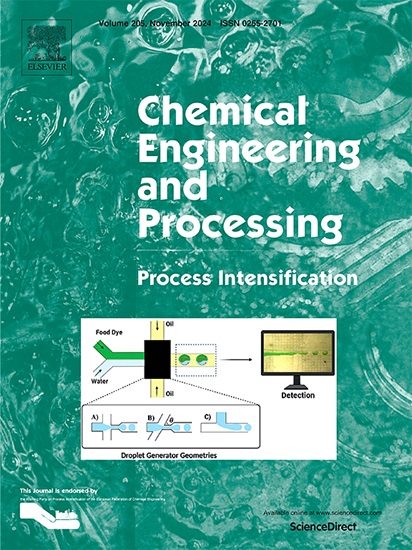Numerical study of particle deposition and removal behavior in the water-cooled flue of a submerged arc furnace
IF 3.8
3区 工程技术
Q3 ENERGY & FUELS
Chemical Engineering and Processing - Process Intensification
Pub Date : 2025-06-09
DOI:10.1016/j.cep.2025.110404
引用次数: 0
Abstract
To solve the issue of fouling in traditional insulated flues, this study proposed a coil type water-cooled flue. Firstly, a comprehensive fouling model was developed based on the Johnson-Kendall-Roberts (JKR) theory and the Grant and Tabakoff particle-wall rebound model to simulate particle deposition, rebound, and removal behaviors within the water-cooled flue. Then, the effects of the cooling water inlet velocity, wall roughness, and inflection angle of tee section on the particle fouling characteristics were investigated. The results show that the particles are primarily deposited in the furnace mouth section, the external corners of the flue between sections I to III, the tee section, and the end of the blind pipe section within water-cooled flues owing to inertial collisions, low-velocity vortices, and thermophoretic force. Additionally, as the inlet velocity of cooling water increases from 0 to 1.6 m/s, the particle fouling mass decreases from 8.63 to 0.48 kg at t = 200 h. Conversely, as wall roughness increases from 0.1 to 1 mm, the particle fouling mass increases from 0.49 to 0.72 kg at t = 18 h. Furthermore, when the inflection angle α of the tee section increases from 60° to 110°, the fouling mass decreases from 0.54 to 0.48 kg at t = 18 h. Based on the comparative study of water-cooled and insulated flues, the water-cooled flue has a significant advantage in reducing particle deposition. To optimize particle deposition, the optimum inlet velocity of cooling water and the angle α are 1.2 m/s and 90°, respectively.

埋弧炉水冷烟道颗粒沉积与去除行为的数值研究
为解决传统保温烟道结垢问题,提出了盘管式水冷烟道。首先,基于Johnson-Kendall-Roberts (JKR)理论和Grant and Tabakoff颗粒壁面回弹模型建立了综合污垢模型,模拟了水冷烟道内颗粒的沉积、回弹和去除行为。在此基础上,研究了冷却水入口流速、壁面粗糙度和三通截面弯曲角对颗粒结垢特性的影响。结果表明:在水冷烟道内,由于惯性碰撞、低速涡旋和热反射力的作用,颗粒主要沉积在炉口段、烟道I ~ III段外角、三通段和盲管末端;此外,随着冷却水入口速度的增加从0到1.6 m / s,粒子污染质量从8.63减少到0.48公斤在t = 200 h。相反,从0.1到1毫米壁粗糙度增加,粒子污染质量从0.49增加到0.72公斤在t = 18 h。此外,当t形截面的弯曲角α增加从60°- 110°,污染质量从0.54减少到0.48公斤在t = 18 h。基于水冷的比较研究和绝缘的流感,水冷烟道在减少颗粒沉积方面具有显著的优势。为了优化颗粒沉积,冷却水的最佳入口流速为1.2 m/s, α角为90°。
本文章由计算机程序翻译,如有差异,请以英文原文为准。
求助全文
约1分钟内获得全文
求助全文
来源期刊
CiteScore
7.80
自引率
9.30%
发文量
408
审稿时长
49 days
期刊介绍:
Chemical Engineering and Processing: Process Intensification is intended for practicing researchers in industry and academia, working in the field of Process Engineering and related to the subject of Process Intensification.Articles published in the Journal demonstrate how novel discoveries, developments and theories in the field of Process Engineering and in particular Process Intensification may be used for analysis and design of innovative equipment and processing methods with substantially improved sustainability, efficiency and environmental performance.

 求助内容:
求助内容: 应助结果提醒方式:
应助结果提醒方式:


